Gorillas are truly fascinating creatures. They are the largest primates on Earth and share an incredible 98% of their DNA with humans. Among their many intriguing behaviors, one stands out for its dramatic flair and deep meaning: chest beating.
Chest beating, a behavior most commonly associated with the mighty silverback gorillas, is much more than just a show of strength. When a gorilla thumps its chest, it creates a resonant sound that can be heard echoing through the forest. This isn’t just random noise; it’s a sophisticated form of communication used in various situations.
So, why do gorillas beat their chests? It’s a way for them to express a range of emotions and intentions. From asserting dominance and deterring rivals to attracting mates or even signaling their location to other group members, chest beating serves multiple purposes. It’s a non-verbal language that speaks volumes about the social dynamics and individual status within a gorilla group.
Interestingly, each gorilla’s chest beat has its own rhythm and tone, almost like a personal signature. This allows other gorillas to identify who is making the sound without seeing them. It’s a crucial part of their social interaction, helping maintain order and communication in the dense forests they inhabit.
In the following sections, we’ll dive deeper into this remarkable behavior, exploring its significance in gorilla society, the physical adaptations that enable it, and how it varies across different contexts and situations. Join us as we unravel the mysteries behind the chest beats of these majestic creatures.
Why Do Gorillas Beat Their Chest
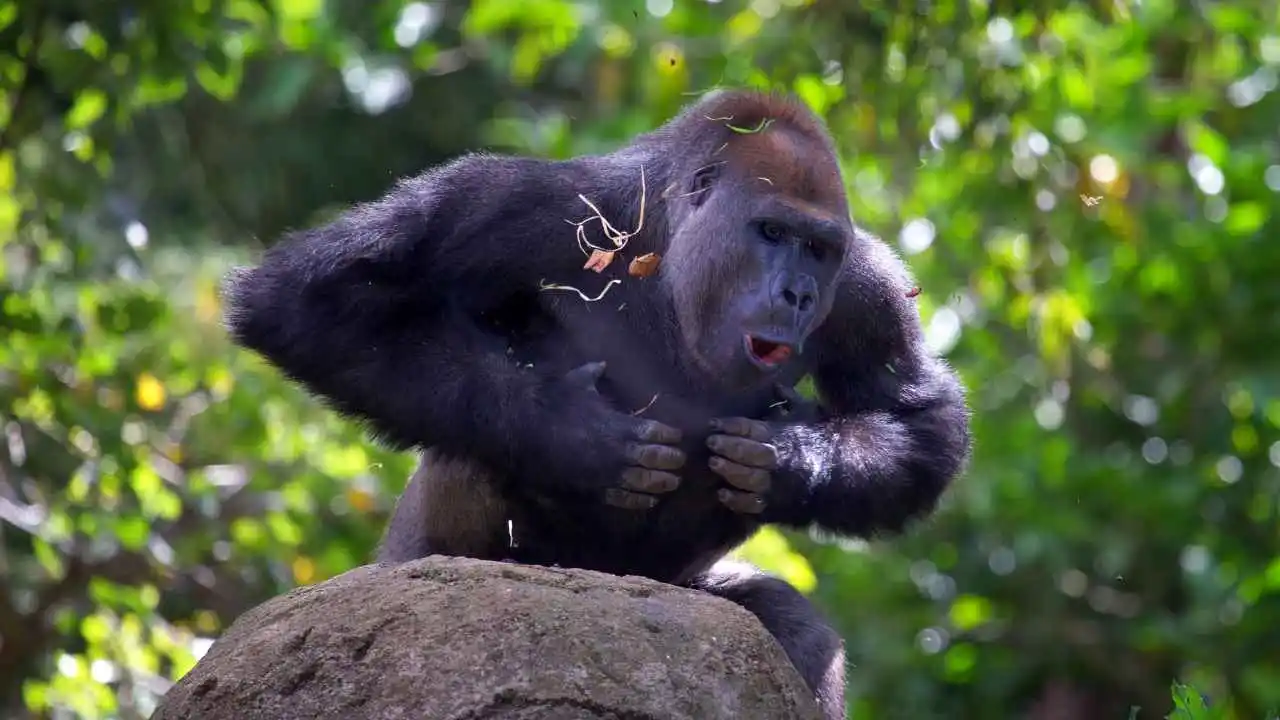
Chest beating is one of the most iconic behaviors of gorillas, but have you ever wondered why they do it? Let’s delve into this fascinating aspect of gorilla life.
Reasons for Chest Beating
- Communication: Gorillas don’t have smartphones or email, so they use chest beating as a way to ‘talk’ over long distances. This can be to let others know where they are or to stay connected with their group in the dense forest.
- Displaying Dominance: Imagine you’re the strongest and biggest gorilla in the group. You want everyone to know that, right? That’s where chest beating comes in. It’s like wearing a badge that says, “I’m the boss here.”
- Mating Rituals: Just like humans dress up for a date, gorillas use chest beating to impress potential mates. It’s their way of showing strength and fitness – important qualities in the gorilla world.
- Response to Threats: When feeling threatened or trying to scare off an intruder, a gorilla might beat its chest. It’s like saying, “Back off, or else!”
Sound and Impact
The sound of chest beating is not just any noise; it’s a deep, resonant drumming that can travel far through the forest. Gorillas have air sacs in their throat that help amplify this sound. It’s like having a built-in speaker system! This sound can tell other gorillas a lot – like who’s making the noise, how big they are, and what mood they’re in.
Chest Beating in Different Contexts
- Social Interactions: In the peaceful moments of gorilla life, chest beating can be a way to maintain social bonds. It’s like checking in with friends and family.
- Encounters with Humans: When humans come too close, some gorillas might beat their chests as a warning. It’s their way of saying, “This is my space.”
- Group Dynamics: The frequency and style of chest beating can change depending on what’s happening in the group. If there’s a dispute or a new leader is emerging, you might hear more chest beating as gorillas figure out their social order.
Anatomy of a Silverback Gorilla

When you look at a silverback gorilla, you’re seeing nature’s masterpiece of strength and power. These magnificent creatures are not just big; they’re built in a way that’s perfect for their lifestyle, especially for their famous chest-beating.
Physical Characteristics
- The Silverback: The most striking feature is their silver-colored back, which is where they get their name. This silver patch is a sign of maturity and leadership in male gorillas.
- Size and Build: Silverbacks are massive, with broad chests and shoulders, thick necks, and muscular arms. They can reach up to 6 feet when standing and weigh as much as 200 to 220 kilograms (440 to 485 pounds). This size isn’t just for show; it’s crucial for their day-to-day activities in the wild.
- Arms and Hands: Their arms are longer and much stronger than their legs, perfect for knuckle-walking and, yes, chest beating. Their hands are large with opposable thumbs, which helps them in gripping and interacting with their environment.
Musculature and Strength
- Muscle Structure: Silverbacks have an incredible muscle structure. Their muscles, especially in their arms and chest, are highly developed. This isn’t just for lifting and carrying things; it’s also essential for their mode of communication – chest beating.
- Strength: When it comes to raw strength, silverbacks are true powerhouses. They are estimated to be about six times stronger than an average human. This strength is a result of their muscle composition and their daily activities like climbing, fighting, and, of course, chest beating.
- Chest Beating Mechanics: The combination of their muscular chest, strong arms, and flexible wrists allows silverbacks to beat their chests with great force and frequency. This action is not just a display of power; it’s a nuanced form of communication.
Behavioral and Social Significance
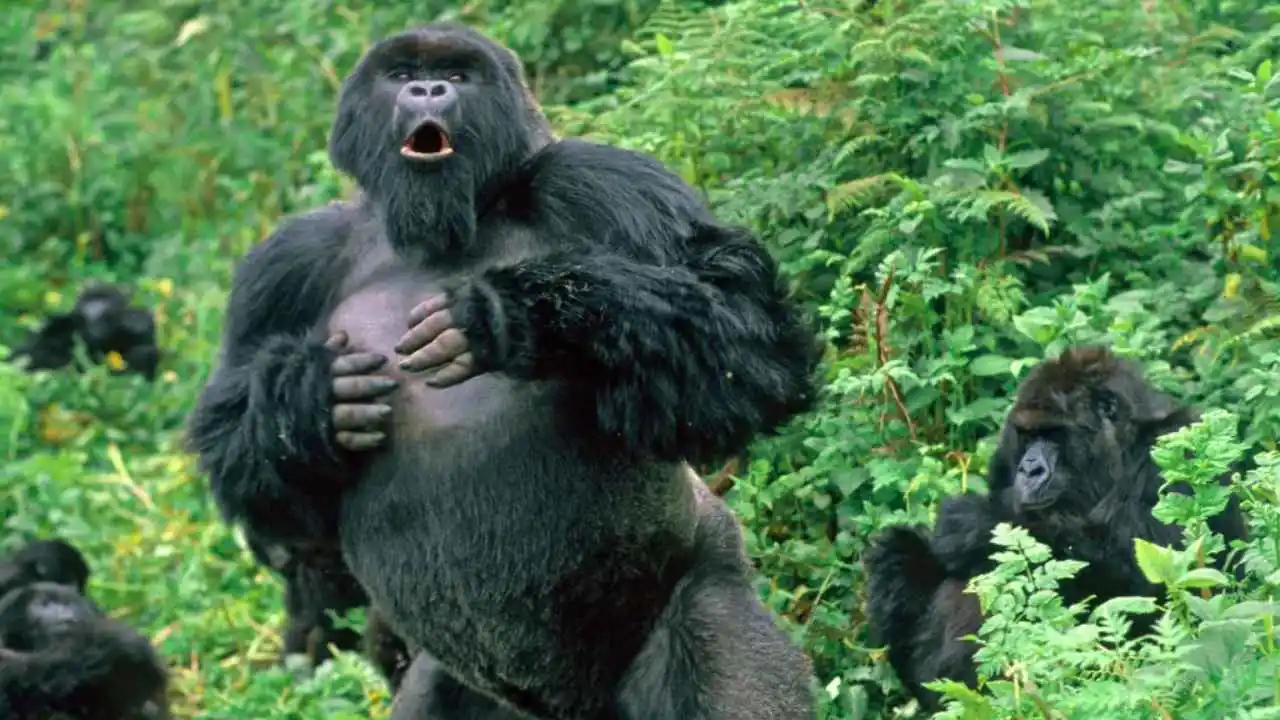
In the world of gorillas, communication is key, and chest beating plays a vital role in their social lives. Let’s explore how this unique behavior influences their social hierarchy and group dynamics.
Social Hierarchy and Chest Beating
- The Role of the Silverback: In a gorilla group, the silverback is the leader and protector. He’s like the king of his family. His chest beating is a powerful way to assert his authority and leadership. It’s his way of saying, “I’m in charge here.”
- Respect and Recognition: When the silverback beats his chest, it’s a signal to other gorillas to recognize his position. It’s not just about showing off; it’s about maintaining order and respect within the group.
- Determining Hierarchy: Younger males, or blackbacks, also beat their chests, but it’s different. They might be trying to show they’re growing up and getting stronger, kind of like teenagers trying to prove themselves.
Chest Beating and Group Dynamics
- Conflict Resolution: Sometimes, gorillas have disagreements, just like us. Chest beating can be a way to resolve these without actually fighting. It’s like saying, “Look how strong I am, you don’t want to fight me,” which can prevent conflicts from escalating.
- Leadership Assertion: When a new silverback takes over or a young male challenges the leader, chest beating becomes crucial. It’s a way for them to say, “I’m strong enough to lead.” This helps in establishing and asserting leadership within the group.
- Group Cohesion: Chest beating also plays a role in keeping the group together. It’s a way of communicating across distances in the dense forest. When the silverback beats his chest, it can be a signal for the group to gather or to follow him.
Comparative Analysis with Other Primates
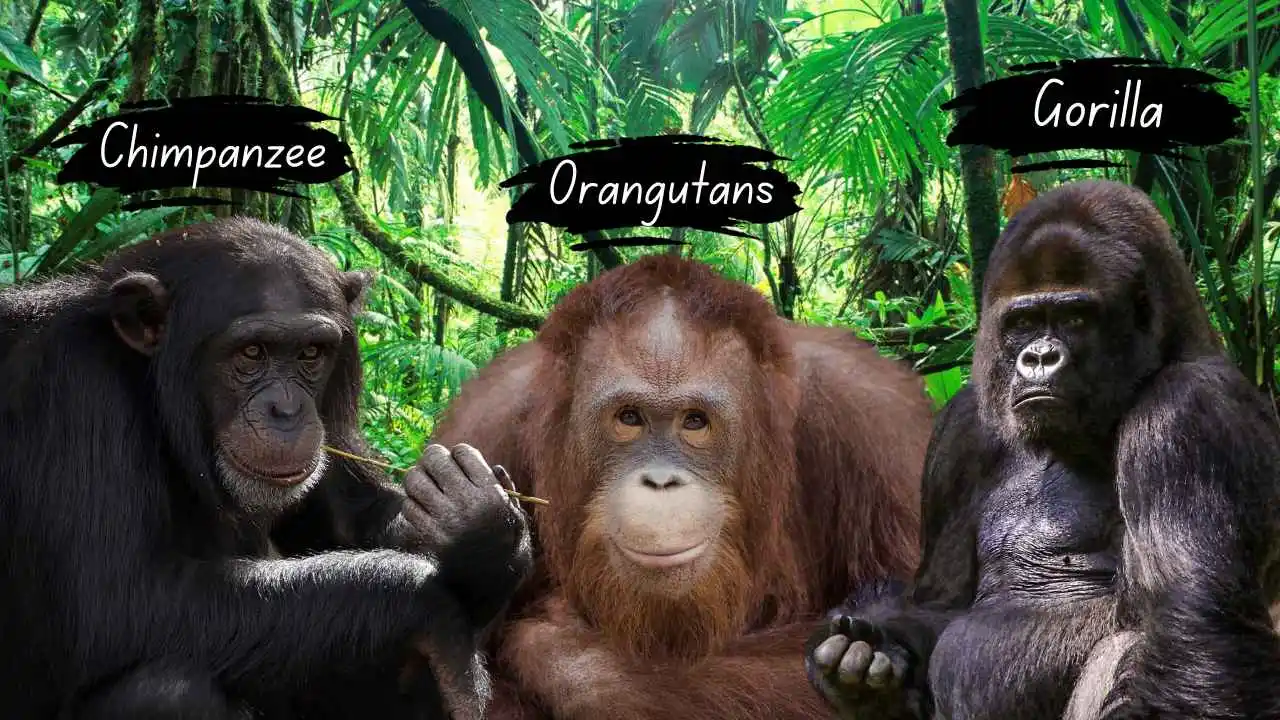
When we look at the animal kingdom, especially among primates, we find that gorillas aren’t the only ones with unique ways of communicating and showing off their strength. Let’s compare gorilla chest beating with similar behaviors in other primates and explore the evolutionary story behind these actions.
Similar Behaviors in Other Primates
- Chimpanzees: Our closest relatives, chimpanzees, have their own display behaviors. They might drum on tree trunks or use loud vocalizations. It’s like their version of chest beating, used for communication and showing dominance, but it’s less about physical strength and more about making noise.
- Orangutans: Orangutans are more solitary, but they still have impressive ways of showing off. They make loud, long calls that can be heard far away. It’s not chest beating, but it serves a similar purpose – to communicate across large distances and assert their presence.
- Unique Aspects of Gorilla Chest Beating: What sets gorillas apart is the physicality of their chest beating. It’s not just about making noise; it’s a full-body display of strength and size, something that’s quite unique to gorillas.
Evolutionary Perspective
- Why Chest Beating?: From an evolutionary standpoint, chest beating likely developed as a way for gorillas to communicate without needing to see each other in dense forests. It’s an efficient way to send messages – whether it’s “stay away,” “I’m here,” or “follow me.”
- Significance in Evolution: This behavior could have evolved as a non-aggressive way to resolve conflicts and establish social hierarchies. In the animal world, avoiding actual fights is often beneficial as it reduces the risk of injury. Chest beating is a perfect solution – it’s a show of strength that doesn’t involve physical combat.
- Adaptation to Environment: Gorillas’ natural habitat in dense forests makes visual communication challenging. Chest beating, which can be heard over long distances, is an excellent adaptation to this environment. It’s a way to ‘talk’ through the thick foliage.
Misconceptions and Human Interpretations
When it comes to gorillas and their chest-beating behavior, there are a few misunderstandings that often pop up. Let’s clear those up and also look at how this behavior has been portrayed in human culture.
Addressing Common Misconceptions
- Not Always Aggression: A big misconception is that gorillas beat their chests only as a sign of aggression. In reality, it’s much more versatile. Yes, it can be a warning or a show of dominance, but it’s also used for communication within the group, attracting mates, and even just as a way to express excitement or other emotions.
- Not Just for Males: While silverback gorillas are the most famous for chest beating, it’s not exclusive to them. Younger males and even females can and do beat their chests, though less frequently and with less intensity.
Cultural Representations
Gorilla chest beating has been a popular feature in movies, books, and cartoons. Often, it’s portrayed as a fearsome display of raw power, sometimes even with a hint of violence. Think of King Kong pounding his chest in a classic movie scene. While this makes for dramatic storytelling, it’s not entirely accurate. In reality, gorilla behavior is much more nuanced and is often more about communication than intimidation.
Conclusion
To sum up, chest beating in gorillas is a complex and multifaceted behavior. It’s not just a display of aggression or strength but a form of communication that plays a vital role in their social lives. Understanding this behavior helps us appreciate gorillas as more than just powerful animals; they are intelligent, social beings with intricate ways of interacting with each other.
Importance of Understanding Gorilla Behavior
Recognizing the true nature of behaviors like chest beating is crucial for conservation efforts and scientific research. It helps us understand gorilla needs and social structures, which is vital for protecting these magnificent creatures and ensuring their survival.
References and Further Reading
For those interested in learning more, here are some credible sources:
- “Gorillas in the Mist” by Dian Fossey – A classic work on gorilla behavior and conservation.
- National Geographic – Offers a range of articles and documentaries on gorillas.
- The Dian Fossey Gorilla Fund International – Provides updated research and information on gorillas.
- “Behavioral Ecology of the Mountain Gorilla” by George B. Schaller – A detailed study on gorilla behavior.
- BBC Wildlife Documentaries – Often feature insightful segments on gorillas and their habits.



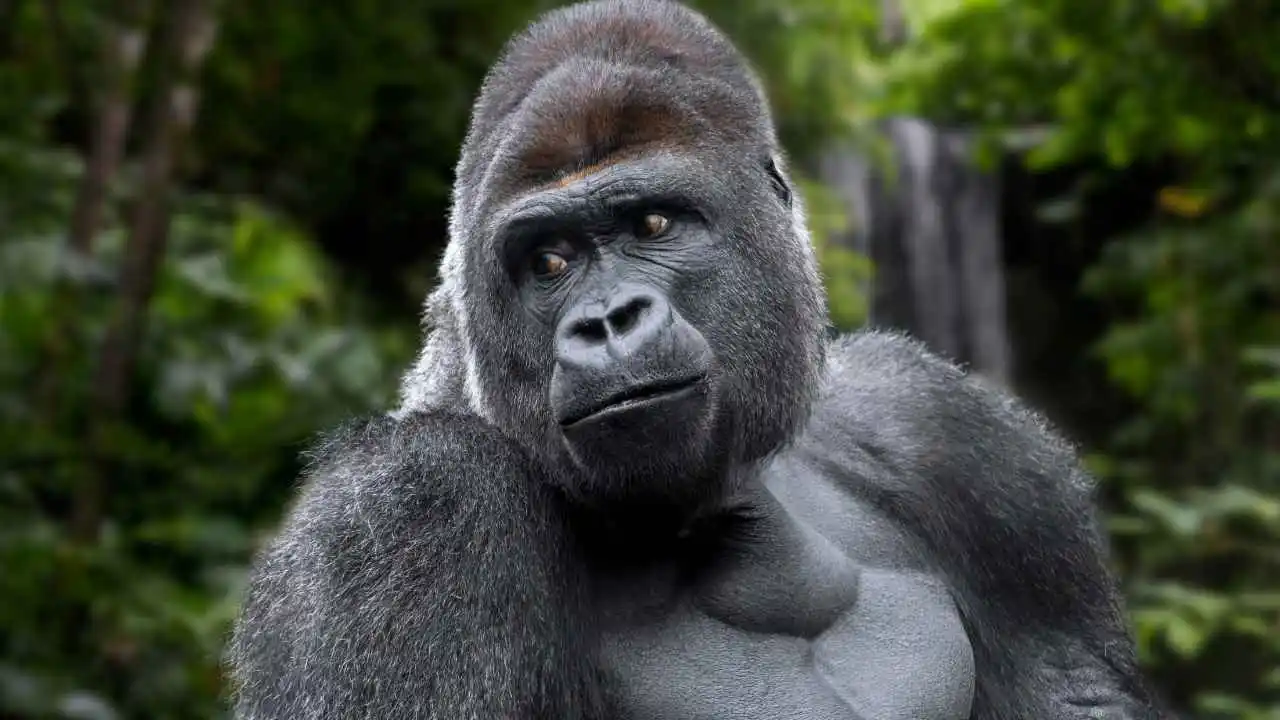
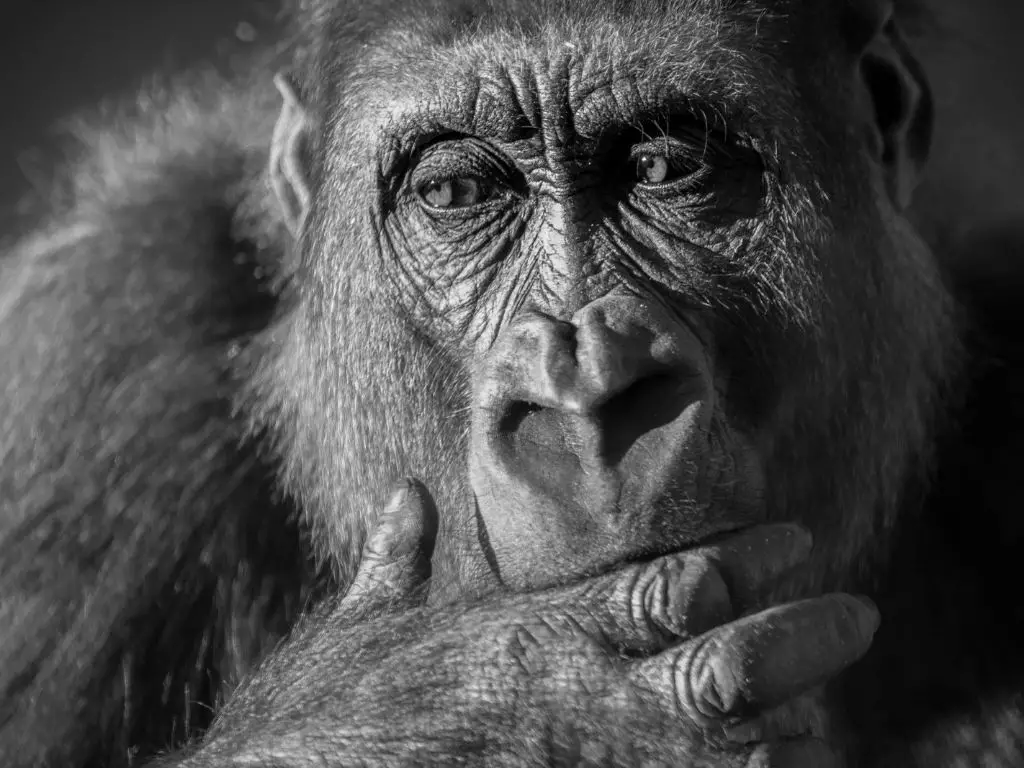
Leave a Reply